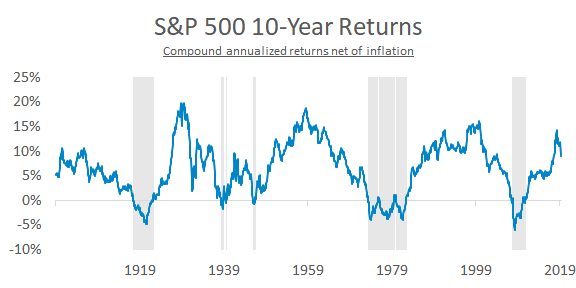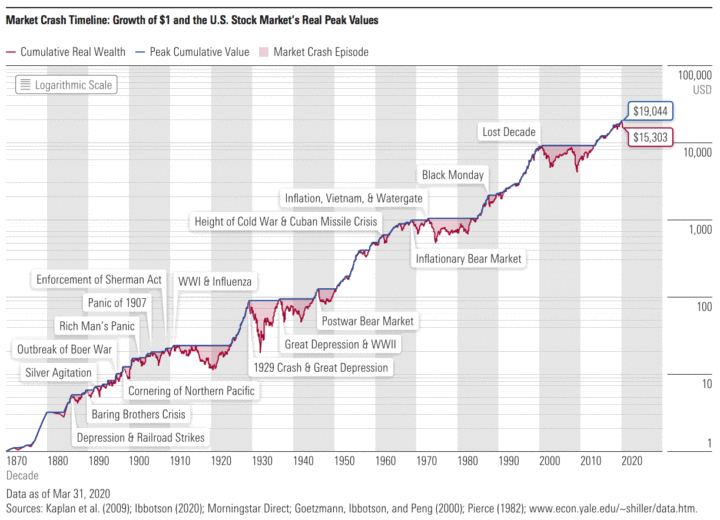Many investing articles basically keep telling you “Don’t worry! stocks always go up!”, but I appreciated the added perspective from the Morningstar article What Prior Market Crashes Can Teach Us About Navigating the Current One by Paul D. Kaplan and The Risk of a Lost Decade For Stocks by Movement Capital. Here is the growth of $1 in the US stock market since 1871, adjusted for inflation.
The first takeaway is that severe stock market drops are not uncommon. Having the emotional fortitude that the drops are not permanent is important.
This historical stock market return data provides clear evidence that market crashes aren’t as unique as one might have thought. The term “black turkey” is more apt, since they appear every so often—and today’s coronavirus-caused crash is only the most recent example.
The second takeaway is that there are many red periods where the stock market doesn’t reach the previous high-water mark for a decade or longer. You also need the patience to ride out those discouraging periods.

I think the average investor has an overly optimistic base case for how stocks perform over 10-year horizons. The S&P 500 has spent one-tenth of the time since 1900 with a negative inflation-adjusted return over the prior decade.
The 54% drop from August 2000 to February 2009, also known as the Lost Decade. The second-worst drop on the chart, this period started when the dot-com bubble burst. The market began recovering but not enough to get the cumulative value back to its August 2000 level before the crash of 2007-09. It didn’t reach that level until May 2013—almost 12 and a half years after the initial crash.
So often the takeaway from these long-term stock market charts is simply that the line always goes up eventually. Yes, but the line can also go nowhere for a decade or more. I’m not saying that this will happen now, but these are the hardships that create the “equity risk premium”. If stocks gave us stable price increases, they wouldn’t provide such high returns. As stock investors, we have to prepare for both the sudden shocks and the long, painful “lost” decades.

 The Best Credit Card Bonus Offers – 2025
The Best Credit Card Bonus Offers – 2025 Big List of Free Stocks from Brokerage Apps
Big List of Free Stocks from Brokerage Apps Best Interest Rates on Cash - 2025
Best Interest Rates on Cash - 2025 Free Credit Scores x 3 + Free Credit Monitoring
Free Credit Scores x 3 + Free Credit Monitoring Best No Fee 0% APR Balance Transfer Offers
Best No Fee 0% APR Balance Transfer Offers Little-Known Cellular Data Plans That Can Save Big Money
Little-Known Cellular Data Plans That Can Save Big Money How To Haggle Your Cable or Direct TV Bill
How To Haggle Your Cable or Direct TV Bill Big List of Free Consumer Data Reports (Credit, Rent, Work)
Big List of Free Consumer Data Reports (Credit, Rent, Work)
I think your takeaways are more from the perspective of a investor who’s past the accumulation phase of their life and looking to live off of their investments.
To me it seems that this perspective might give a new investor the impression that it would be better to look elsewhere to put their money since the market went nowhere for 10-15 years. But the truth is, I (and you as well, I believe) built most of our wealth during the “lost decade” and the years after, though looking the chart, you might not believe that to be possible. With steady, periodic investment in the broad market over that period, you would have done quite well.
Thanks for your comment. I didn’t mean it to come off that way – Stocks are definitely the long-term answer, I am just trying to prepare people it’s not as easy as people say it is after a bull market. Even now, I believe it is a bull market (we are back to 2019 levels). I would argue that the reason you built wealth during the lost decade is exactly because you had patience, and you eventually got to the other side of 2010-2020 returns. If you started in 1998 and it was 2008, you might feel discouraged, no?
On a related note, I remember your portfolio consisting of developed (ex-US); emerging and small cap value.
Given that emerging and small cap value have underperformed in bull and bear markets do you still believe this diversification is justified? Could Fama French small cap value factor be irrelevant?
Same for developed and emerging economies?